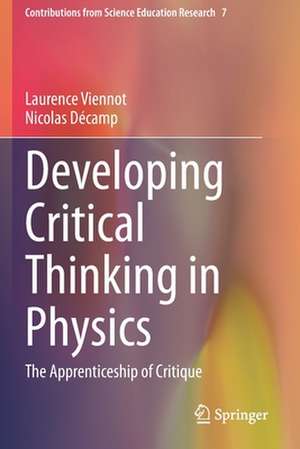Developing Critical Thinking in Physics: The Apprenticeship of Critique: Contributions from Science Education Research, cartea 7
Autor Laurence Viennot, Nicolas Décampen Limba Engleză Paperback – 14 iul 2021
| Toate formatele și edițiile | Preț | Express |
|---|---|---|
| Paperback (1) | 774.35 lei 6-8 săpt. | |
| Springer International Publishing – 14 iul 2021 | 774.35 lei 6-8 săpt. | |
| Hardback (1) | 780.19 lei 6-8 săpt. | |
| Springer International Publishing – 14 iul 2020 | 780.19 lei 6-8 săpt. |
Preț: 774.35 lei
Preț vechi: 944.33 lei
-18% Nou
Puncte Express: 1162
Preț estimativ în valută:
148.22€ • 161.05$ • 124.58£
148.22€ • 161.05$ • 124.58£
Carte tipărită la comandă
Livrare economică 21 aprilie-05 mai
Preluare comenzi: 021 569.72.76
Specificații
ISBN-13: 9783030437756
ISBN-10: 3030437752
Ilustrații: VII, 142 p. 55 illus.
Dimensiuni: 155 x 235 mm
Greutate: 0.22 kg
Ediția:1st ed. 2020
Editura: Springer International Publishing
Colecția Springer
Seria Contributions from Science Education Research
Locul publicării:Cham, Switzerland
ISBN-10: 3030437752
Ilustrații: VII, 142 p. 55 illus.
Dimensiuni: 155 x 235 mm
Greutate: 0.22 kg
Ediția:1st ed. 2020
Editura: Springer International Publishing
Colecția Springer
Seria Contributions from Science Education Research
Locul publicării:Cham, Switzerland
Cuprins
Chapter 1. Why critique ? Why physics?.- Chapter 2. Main reasons to call a text into question.- Chapter 3. Risk factors.- Chapter 4. Benefits and limits of a classification.- Chapter 5. Conceptual mastery and critical attitude: complex links.- Chapter 6. Activating criticism without delay.- Chapter 7. An education in critical analysis.- Chapter 8. Critique: a prelude to deeper comprehension.- Appendices A, B, C, D, E, F, G, H, I, J.
Notă biografică
Laurence Viennot is Professor Emeritus of Physics at the University of Paris, in the Laboratory of Matter and Complex Systems. After a few years of research in astrophysics, she turned to the didactics of physics, of which she is one of the pioneers at the international level. She was a member of the first board of European Science Education Research Association. Among her research themes, common reasoning in physics and the development and evaluation of teaching sequences in physics occupy a major place. She has received two international medals (IUPAPE and GIREP). Her current research focuses on the development of critical thinking in physics students.
After having defended a thesis on the interstellar medium, worked on turbulence and taught for a few years in high school, Nicolas Décamp is now a lecturer at the Physics Department of the University of Paris. He is in charge of the master's degree in physics teaching and conductsresearch at the André Revuz didactics laboratory, in particular on the links between the history of science and physics didactics and on the development of critical thinking in physics students.
After having defended a thesis on the interstellar medium, worked on turbulence and taught for a few years in high school, Nicolas Décamp is now a lecturer at the Physics Department of the University of Paris. He is in charge of the master's degree in physics teaching and conductsresearch at the André Revuz didactics laboratory, in particular on the links between the history of science and physics didactics and on the development of critical thinking in physics students.
Textul de pe ultima copertă
This book promotes the effective implementation and development of critical analysis in physics. It focuses on explanatory texts concerning subjects typically dealt with in secondary or higher education and addressed in an academic or popular context. It highlights the general difficulties and obstacles inherent in teaching physics and shows how some tools can help to combine successful criticism and better understanding. The book examines the main reasons to call a text into question and looks at risk factors such as simplifications, story-like explanations and visual analogies. It takes inventory of the benefits and limits of critical analysis and discusses the complex links between conceptual mastery and critical attitude. The book ends by offering tools to activate critical thinking and ways for educators to guide students towards productive critical analysis.
Caracteristici
Provides a systematic approach to analysing explanations in physics Shows the value of a critically alert approach to science texts Goes beyond basic advice about critical thinking












